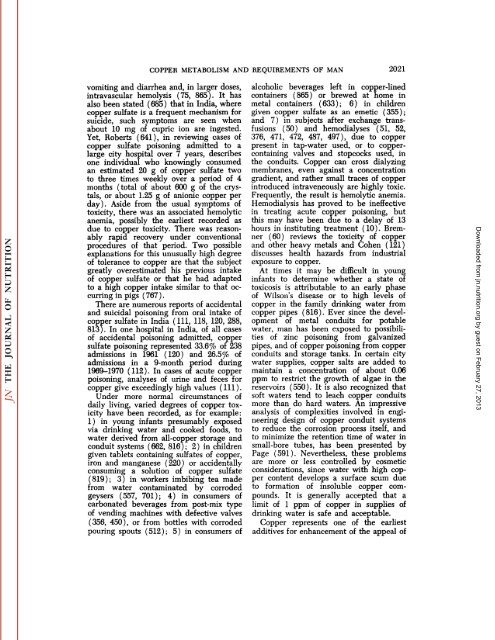conspectus of researchon copper metabolism and requirements
conspectus of researchon copper metabolism and requirements
conspectus of researchon copper metabolism and requirements
You also want an ePaper? Increase the reach of your titles
YUMPU automatically turns print PDFs into web optimized ePapers that Google loves.
COPPER METABOLISM AND REQUIREMENTS OF MAN 2021<br />
vomiting <strong>and</strong> diarrhea <strong>and</strong>, in larger doses,<br />
intravascular hemolysis (75, 865). It has<br />
also been stated ( 685 ) that in India, where<br />
<strong>copper</strong> sulfate is a frequent mechanism for<br />
suicide, such symptoms are seen when<br />
about 10 mg <strong>of</strong> cupric ion are ingested.<br />
Yet, Roberts (641), in reviewing cases <strong>of</strong><br />
<strong>copper</strong> sulfate poisoning admitted to a<br />
large city hospital over 7 years, describes<br />
one individual who knowingly consumed<br />
an estimated 20 g <strong>of</strong> <strong>copper</strong> sulfate two<br />
to three times weekly over a period <strong>of</strong> 4<br />
months (total <strong>of</strong> about 600 g <strong>of</strong> the crys<br />
tals, or about 1.25 g <strong>of</strong> anionic <strong>copper</strong> per<br />
day). Aside from the usual symptoms <strong>of</strong><br />
toxicity, there was an associated hemolytic<br />
anemia, possibly the earliest recorded as<br />
due to <strong>copper</strong> toxicity. There was reason<br />
ably rapid recovery under conventional<br />
procedures <strong>of</strong> that period. Two possible<br />
explanations for this unusually high degree<br />
<strong>of</strong> tolerance to <strong>copper</strong> are that the subject<br />
greatly overestimated his previous intake<br />
<strong>of</strong> <strong>copper</strong> sulfate or that he had adapted<br />
to a high <strong>copper</strong> intake similar to that oc<br />
curring in pigs (767 ).<br />
There are numerous reports <strong>of</strong> accidental<br />
<strong>and</strong> suicidal poisoning from oral intake <strong>of</strong><br />
<strong>copper</strong> sulfate in India (111, 118, 120, 288,<br />
813). In one hospital in India, <strong>of</strong> all cases<br />
<strong>of</strong> accidental poisoning admitted, <strong>copper</strong><br />
sulfate poisoning represented 33.6% <strong>of</strong> 238<br />
admissions in 1961 (120) <strong>and</strong> 26.5% <strong>of</strong><br />
admissions in a 9-month period during<br />
1969-1970 (112). In cases <strong>of</strong> acute <strong>copper</strong><br />
poisoning, analyses <strong>of</strong> urine <strong>and</strong> feces for<br />
<strong>copper</strong> give exceedingly high values (111).<br />
Under more normal circumstances <strong>of</strong><br />
daily living, varied degrees <strong>of</strong> <strong>copper</strong> tox<br />
icity have been recorded, as for example:<br />
1) in young infants presumably exposed<br />
via drinking water <strong>and</strong> cooked foods, to<br />
water derived from all-<strong>copper</strong> storage <strong>and</strong><br />
conduit systems (662, 816); 2) in children<br />
given tablets containing sulfates <strong>of</strong> <strong>copper</strong>,<br />
iron <strong>and</strong> manganese (220) or accidentally<br />
consuming a solution <strong>of</strong> <strong>copper</strong> sulfate<br />
(819); 3) in workers imbibing tea made<br />
from water contaminated by corroded<br />
geysers (557, 701); 4) in consumers <strong>of</strong><br />
carbonated beverages from post-mix type<br />
<strong>of</strong> vending machines with defective valves<br />
(356, 450), or from bottles with corroded<br />
pouring spouts (512); 5) in consumers <strong>of</strong><br />
alcoholic beverages left in <strong>copper</strong>-lined<br />
containers (865) or brewed at home in<br />
metal containers (633); 6) in children<br />
given <strong>copper</strong> sulfate as an emetic (355 ) ;<br />
<strong>and</strong> 7) in subjects after exchange trans<br />
fusions (50) <strong>and</strong> hemodialyses (51, 52,<br />
376, 471, 472, 487, 497), due to <strong>copper</strong><br />
present in tap-water used, or to <strong>copper</strong>containing<br />
valves <strong>and</strong> stopcocks used, in<br />
the conduits. Copper can cross dialyzing<br />
membranes, even against a concentration<br />
gradient, <strong>and</strong> rather small traces <strong>of</strong> <strong>copper</strong><br />
introduced intraveneously are highly toxic.<br />
Frequently, the result is hemolytic anemia.<br />
Hemodialysis has proved to be ineffective<br />
in treating acute <strong>copper</strong> poisoning, but<br />
this may have been due to a delay <strong>of</strong> 13<br />
hours in instituting treatment (10). Bremner<br />
(60) reviews the toxicity <strong>of</strong> <strong>copper</strong><br />
<strong>and</strong> other heavy metals <strong>and</strong> Cohen (121)<br />
discusses health hazards from industrial<br />
exposure to <strong>copper</strong>.<br />
At times it may be difficult in young<br />
infants to determine whether a state <strong>of</strong><br />
toxicosis is attributable to an early phase<br />
<strong>of</strong> Wilson's disease or to high levels <strong>of</strong><br />
<strong>copper</strong> in the family drinking water from<br />
<strong>copper</strong> pipes (816). Ever since the devel<br />
opment <strong>of</strong> metal conduits for potable<br />
water, man has been exposed to possibili<br />
ties <strong>of</strong> zinc poisoning from galvanized<br />
pipes, <strong>and</strong> <strong>of</strong> <strong>copper</strong> poisoning from <strong>copper</strong><br />
conduits <strong>and</strong> storage tanks. In certain city<br />
water supplies, <strong>copper</strong> salts are added to<br />
maintain a concentration <strong>of</strong> about 0.06<br />
ppm to restrict the growth <strong>of</strong> algae in the<br />
reservoirs (550). It is also recognized that<br />
s<strong>of</strong>t waters tend to leach <strong>copper</strong> conduits<br />
more than do hard waters. An impressive<br />
analysis <strong>of</strong> complexities involved in engi<br />
neering design <strong>of</strong> <strong>copper</strong> conduit systems<br />
to reduce the corrosion process itself, <strong>and</strong><br />
to minimize the retention time <strong>of</strong> water in<br />
small-bore tubes, has been presented by<br />
Page (591). Nevertheless, these problems<br />
are more or less controlled by cosmetic<br />
considerations, since water with high cop<br />
per content develops a surface scum due<br />
to formation <strong>of</strong> insoluble <strong>copper</strong> com<br />
pounds. It is generally accepted that a<br />
limit <strong>of</strong> 1 ppm <strong>of</strong> <strong>copper</strong> in supplies <strong>of</strong><br />
drinking water is safe <strong>and</strong> acceptable.<br />
Copper represents one <strong>of</strong> the earliest<br />
additives for enhancement <strong>of</strong> the appeal <strong>of</strong><br />
Downloaded from<br />
jn.nutrition.org<br />
by guest on February 27, 2013
















